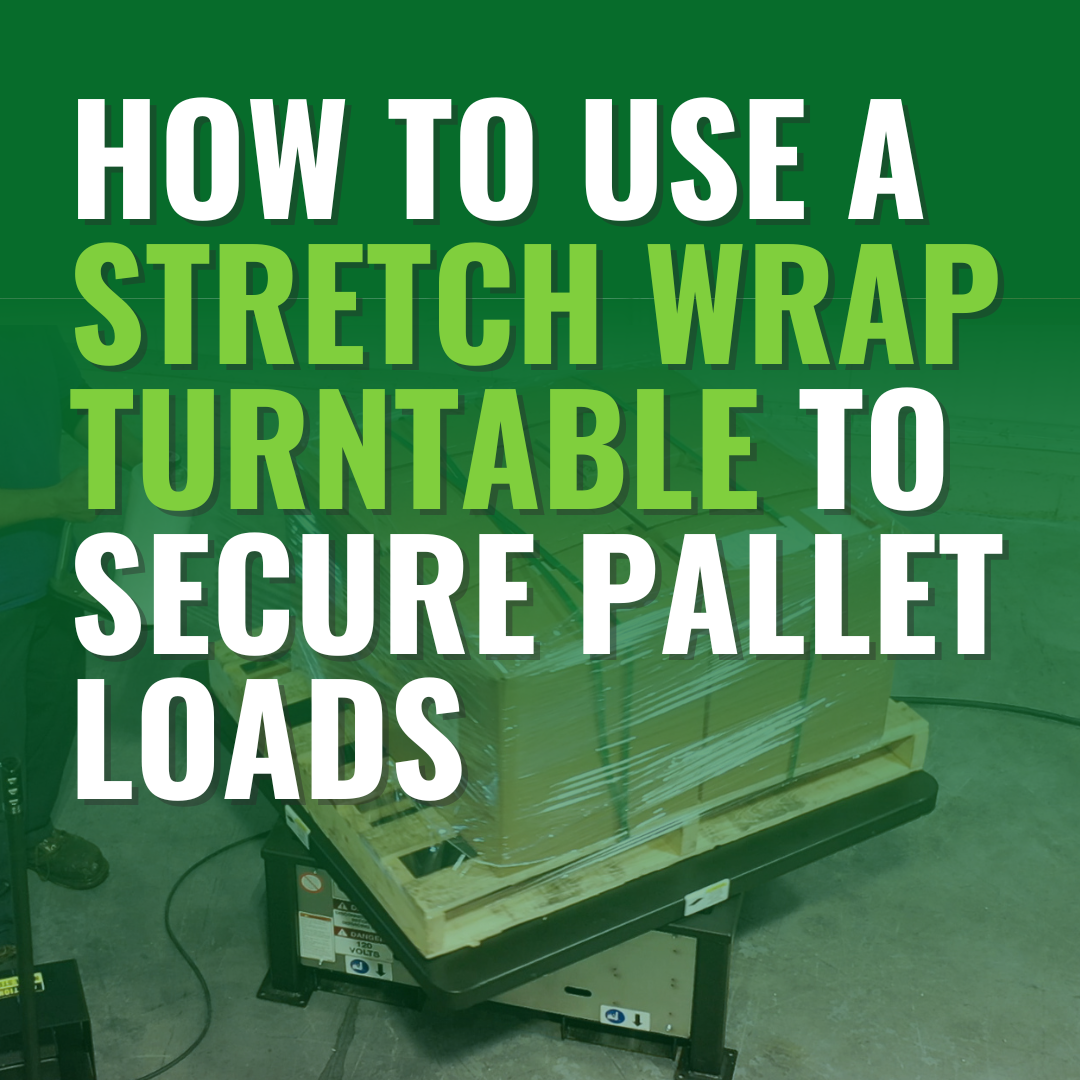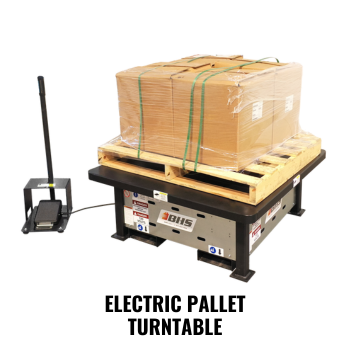We use cookies to make your experience better. To comply with the new e-Privacy directive, we need to ask for your consent to set the cookies. Learn more.
How to Use a Stretch Wrap Turntable to Secure Pallet Loads
Wrapping pallets by hand is hard work — and potentially hazardous.
Manual wrapping requires awkward positioning, stretching, and bending, which can raise the risk of musculoskeletal disorders (MSDs). A stretch wrap turntable makes the job much less difficult (and much more efficient).

In fact, the Occupational Safety and Health Administration (OSHA) specifically recommends using a mechanical stretch wrapper to eliminate the ergonomic hazards associated with stretch-wrapping.
In this article, we’ll discuss the basics of using electric turntables for palletizing. We’ll also outline OSHA’s general requirements for mechanical stretch-wrapping equipment.
Guidelines for Using an Electric Stretch Wrap Turntable
Pallet turntables (also known as pallet rotators) spin their loads while operators remain in a steady position, applying the wrapping material to the load. Essentially, the turntable enables workers to wrap loads of different sizes and shapes, protecting the product during transport.
The type of stretch wrap is important. Most distribution centers and warehouses use cast LLDPE (low-density polyethylene), an inexpensive material suitable for medium-duty pallet wraps. Blow LLDPE film is a more appropriate choice for heavier loads.
Workers must understand the characteristics of the material (such as its strength, puncture resistance, and film yield) when deciding how to wrap each load. The pallet turntable will make the job easier — but it won’t make up for poor technique.
Of course, every pallet introduces different challenges and requires different techniques. However, some general rules can help your team take the right approach (and avoid damaged product or wasted stretch wrap):
- Make sure pallets are in good condition and capable of supporting the full load.
- Always start wrapping at the bottom of the pallet, moving up. Many operators weave a “rope" of LLDPE through the slats of the pallet, which makes handling easier.
- Wrap at least two layers of stretch wrap around the base. This keeps the load secured to the frame of the pallet.
- The general rule is to use overlays of 50% for each successive layer. In other words, each new circle of LLDPE should cover half of the circle of the previous layer.
- Pack tightly, but pay attention to the tension. Lighter loads need less tension (and are generally more likely to suffer damage if the wrap is packed too tightly).
- If necessary, double-wrap the load. This is often required for heavy-duty loads — and while excessive stretch-wrap can create a challenge during unpacking, lost product is a greater concern.
- Workers may tie off the wrap by knotting the end of the wrap material. Alternatively, the wrap’s tie-off may be tucked against a seam; once again, the right approach will depend on the characteristics of the load.
Stretch wrapping is much easier when operators have ample control over the rotation of the load. Look for pallet turntables with variable rotation speeds — and ensure that workers can operate the controls without disrupting the wrap.
Product to Consider: PETA4K-4848 Electric Pallet Turntable
For safe, efficient palletizing, Solus Group carries the PTE4K-4848 Electric Pallet Turntable. With a load capacity of 4,000 lb. (1814 kg.), the PTE4K-4848 is compatible with all standard size pallets.
Key features of the Electric Pallet Turntable:
- A 48" by 48" table top supports standard pallets; custom sizes are also available.
- Variable-speed rotation moves loads from 0 to 12 revolutions per minute, providing operators with effortless control during stretch-wrapping.
- Two-way fork pockets allow travel via lift truck.
- High-profile design allows forklifts to approach from any angle.
- Pre-drilled anchor holes allow for permanent installation.
By eliminating a major ergonomic hazard — and enabling quick wrapping, even or unconventional loads — the Electric Pallet Turntable makes an ideal addition to any pallet-handling operation.
OSHA Requirements for Stretch Wrap Turntables and Palletizing Equipment
There’s one more factor to consider when building your operation’s palletizing processes: OSHA compliance.
Stretch-wrapping pallets by hand may constitute a violation of OSHA’s General Duty Clause, which has been interpreted to include ergonomic hazards. Of course, manual stretch-wrapping is extremely common — but the General Duty Clause still applies.
And since manual wrapping creates ergonomic hazards while limiting throughput, it’s in your best interest to automate as much of the process as possible. Stretch wrap turntables can provide a solution.
As with all industrial equipment, employers should carefully evaluate pallet turntables to ensure OSHA compliance. Most importantly, the machine’s turning mechanism must be safe.
29 CFR 1910.212(a)(3)(ii), General Requirements of All Machines, requires that:
"The point of operation of machines, whose operation exposes an employee to injury, shall be guarded. The guarding device shall be in conformity with any appropriate standards therefore, or, in the absence of applicable specific standards, shall be so designed and constructed as to prevent the operator from having any part of his body in the danger zone during the operating cycle."
The PTE4K-4848 has an elevated platform and a foot control with a 5-foot cable, which allows workers to operate the turning mechanism at a safe distance. Additional guarding can also be installed as needed, depending on the application.
Solus Group can help you find the right pallet-wrapping tools for your warehouse, distribution center, or any other type of operation — and customize the equipment to fit your workflow. Call 314.696.0200 to speak with our sales team or submit an info request online.

